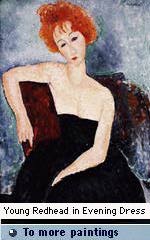|
Modigliani, Amedeo 1884-1920 Italian painter who often painted single figures with long bodies and oval heads, using lines to catch characteristics. Born in Livorno Modigliani studied first in Italy and later in Paris. Under the influence of the sculptor Brancusi he switched to stone sculpture, which prevailed over his painting for some time, but by 1914 the artist was again more interested in painting. After he started to live with Jeanne Hébuterne she became his major model until his death. In 1917 Modigliani's first one-man exhibition was opened in Paris. Unfortunately, the gallery was situated opposite a police station, the chief of which was so scandalized by Modigliani's nudes that he forced him to close the exhibition within a few hours after its opening. In 1918 Modigliani left Paris and went to Nice. There he produced most of the paintings that would later become his most popular and highest-priced works.
www link :
At first Mondrian's work was naturalistic, incorporating successive influences of landscape and still-life painting. After seeing original Cubist works by Braque and Picasso he decided to move to Paris. There he began to develop an independent abstract style. During the war years in Holland, Mondrian further reduced his colors and geometric shapes and formulated his non-objective Neo-Plastic style. He became one of the founders of De Stijl, a group which extended its principles of abstraction and simplification beyond painting to architecture and industrial design. In 1919 he returned to Paris where he exhibited with De Stijl, but he withdrew from the group after van Doesburg reintroduced diagonal elements into his work. World War II forced Mondrian to move to New York. There he joined American Abstract Artists and continued to publish texts on Neo-Plasticism. His late style evolved significantly in response to the city.
www link :
During the 1860s Monet was associated with Edouard Manet, and with other aspiring French painters destined to form the impressionist school - Pissarro, Renoir, and Sisley. Monet at first painted simple landscapes but soon he experimented by rendering outdoor sunlight with a direct, sketchlike application of bright color. As his style became more daring, he seemed to cut himself off from the possibility of a successful career as a conventional painter supported by the art establishment. In 1874 Monet and his colleagues decided to appeal directly to the public by organizing their own exhibition. They called themselves independents, but the press soon called them impressionists because their work seemed sketchy and unfinished (like a first impression) and because one of Monet's paintings had borne the title Impression. In 1890 he purchased property in Giverny, not far from Paris, and there he began to construct a water garden - a lily pond arched with a Japanese bridge and overhung with willows and clumps of bamboo. Beginning in 1906, paintings of the pond and the water lilies occupied him for the remainder of his life.
www link :
|


